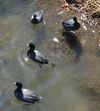Genus Fulica
Hawaiian coot - The first reference to a coot in the Hawaiian Islands was by Andrew Bloxam, who saw it, although he did not collect a specimen, while in the islands in 1825 as the naturalist on board HMS Blonde. He mistook it for the Eurasian Coot, Fulica atra. It is now considered either to be a separate species, Fulica alai, or a subspecies of the American Coot, Fulica americana alai.
Alae keokeo - The American Coot is a bird of the family Rallidae, inhabiting wetlands and open water bodies. About 16 inches in length and weighing 1.4 lb , adults have a short thick white bill and white frontal shield, which usually has a reddish-brown spot near the top of the bill between the eyes. From up close, a dark band can be distinguished at the billtip. The body is grey with the head and neck darker than the rest of the body. Their legs are yellowish, with scalloped toes rather than webbed feet. Their chicks have black bodies with bright red head and beak, and orange plumes around the neck. The call is a high-pitched squeaking honk somewhat like a goose's but more hollow sounding.
Coot - The Eurasian Coot, Fulica atra, also known as Coot, is a member of the rail and crake bird family, the Rallidae. The Australian subspecies is known as the Australian Coot.
Caribbean coot - The adults is 33–38 centimetres long and has a short thick white bill with a reddish-brown spot near the tip and a white forehead shield. The body is grey with the head and neck darker than the rest of the body. The legs are yellow, with scalloped toes rather than webbed feet. It differs from American Coot in that the latter species usually has red knobs at the top of its frontal shield.
Horned Coot - This species of coot was described by Bonaparte in 1853 based on a specimen collected in the Andes of Bolivia. For long it was known only from this type specimen. It is generally a low-density species and the total population has been estimated at 10.000-20.000, with as few as 620 in the Chilean part of its range.
Crested Coot - It is a resident breeder across much of Africa and in southernmost Spain on freshwater lakes and ponds. It builds a nest of dead reeds near the water's edge or afloat, laying up to 8 eggs.
Giant Coot - As in the related Horned Coot, the Giant Coot is monogamous and the pair builts a huge nest in a highland lake. However, unlike the Horned Coot, the nest of the Giant Coot is primarily made of aquatic vegetation and – as it is fiercely territorial – it never forms colonies.
Fulica newtoni - The Mascarene Coot is an extinct species of coot that inhabited the Mascarene islands of Mauritius and Réunion. Long known from subfossil bones found on the former island, but only assumed from descriptions to also have been present on the latter, remains have more recently been found on Réunion also. Early travellers' reports from Mauritius were, in reverse, generally assumed to refer to Common Moorhens, but it seems that this species only colonized the island after the extinction of the endemic coot. The Mascarene Coot was a large bird and while not flightless, it had reduced flying ability, so that if pursued, it would have even more preferred to escape by diving than it is already a general habit of the coots. As the bird had considerable stamina, it could have easily crossed the ocean between the islands, explaining why a single species occurred on both islands. The birds looked like oversized Eurasian Coots, being about 45 cm long, but as they were more likely derived from the Red-knobbed Coot, it







